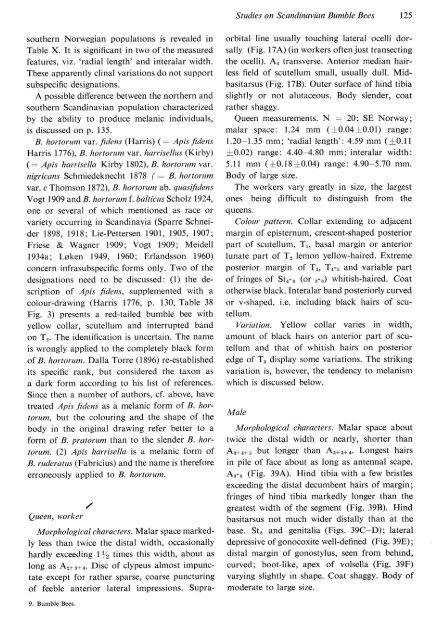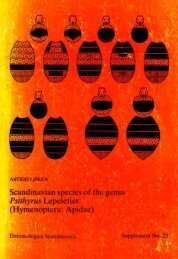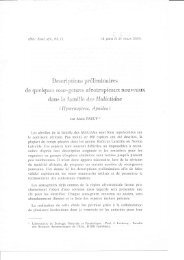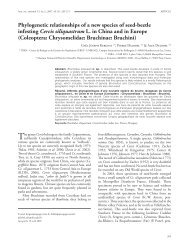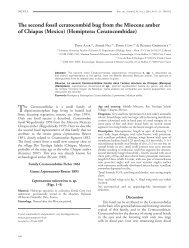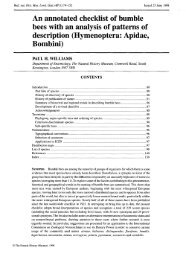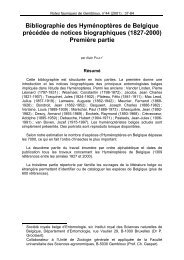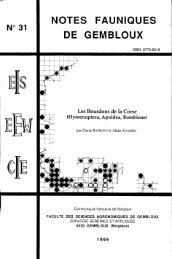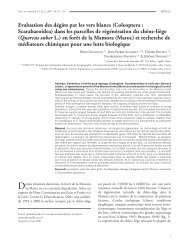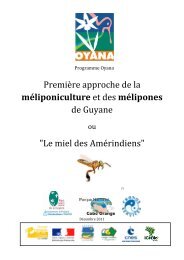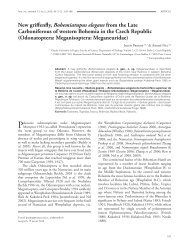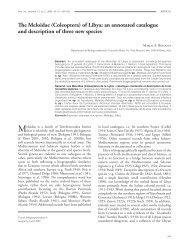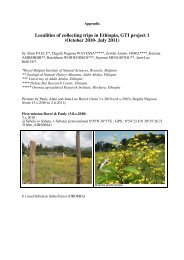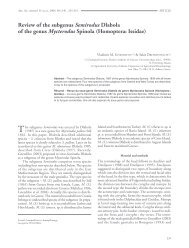Bumble Bees
Bumble Bees
Bumble Bees
You also want an ePaper? Increase the reach of your titles
YUMPU automatically turns print PDFs into web optimized ePapers that Google loves.
Studies on Scandinavian <strong>Bumble</strong> <strong>Bees</strong> 125southern Norwegian populations is revealed inTable X. It is significant in two of the measuredfeatures, viz. 'radial length' and interalar width.These apparently clinal variations do not supportsubspeciflc designations.A possible difference between the northern andsouthern Scandinavian population characterizedby the ability to produce melanic individuals,is discussed on p. 135.B. hortorum var. fidens (Harris) ( - Apis fidensHarris 1776), B. hortorum var. harrisellus (Kirby)(- Apis harrisella Kirby 1802), B. hortorum var.nigricans Schmiedeknecht 1878 ( -,-= B. hortorumvar. c Thomson 1872), B. hortorurn ab. quasffidensVogt 1909 and B. hortorum f . balticzs Scholz 1924,one or several of which mentioned as tace orvariety occurring in Scandinavia (Sparre Schneider1898, 1918 ; Lie-Pettersen 1901, 1905, 1907 ;Friese & Wagner 1909 ; Vogt 1909 ; Meidell1934a; Lsken 1949 , 1960 ; Erlandsson 1960)concern infrasr.lbspecific forms only. Two of thedesignations need to be discussed: (1) the descriptionof Apis fidens, supplemented with acolour-drawing (F{arris 1776, p. 130, Table 38Fig. 3) presents a red-tailed bumble bee withyellor,v collar, scutellum and interrupted bandon Tr. The identification is uncertain. The nameis wrongly applied to the completely black formof B. hortorum. Dalla Torre (1896) re-establishedits specific rank, but considered the taxon asa dark form according to his list of references.Since then a number of authors, cf. above, havetreated Apis fidens as a melanic form of B. hortorum,but the colouring and the shape of thebody in the original drawing refer better to aform of B. pratorum than to the slender B. hortorum.(2) Apis harrisella is a melanic form ofB. ruderatus (Fabricius) and the name is thereforeerroneously applied to B. hortorum./Queen, workerMorphological characters. Malar space markedlyless than twice the distal width, occasionallyhardly exceeding lyz times this width, about aslong as A21 3a a. Disc of clypeus almost impunctateexcept for rather sparse, coarse puncturingof feeble anterior lateral impressions. Supra-orbital line usually touching laterul ocelli dorsally(Fig. 17 A) (in workers often just transectingthe ocelli). An transverse. Anterior median hairlessfield of scutellum small, usually dull. Midbasitarsus(Fig. 17B). Outer surface of hind tibiaslightly or not alutaceous. Body slender, coatrather shaggy.Queen measurements. N - 20; SE Norway;malar space: 1.24 mm (+0.04+0.01) range:1.20-1 .35 mm ; 'radial length' : 4.59 mm ( +0.1 1+0.02) range: 4.40-4.80 mm; interalar width:5.1 1 mm ( +0.18 +0.04) range : 4.90-5.70 mm.Body of large size.The workers vary greatly in size, the largestones being difficult to distinguish from thequeens.Colour pattern Collar extending to adjacentmargin of episternurn, crescent-shaped posteriorpaft of scutellurn, Tr, basal margin or anteriorlunate part of T, lemon yellow-haired. Extremeposterior margin of Tr, Tn-u and variable partof fringes of St^-u (or '-u) whitish-haired. Coatotherwise black. Interalar band posteriorly curvedor v-shaped, i.e. including black hairs of scutellum.Variation. Yellow collar varies in width,amount of black hairs on anterior pafi of scutellumand that of whitish hairs on posterioredge of T, display some variations. The strikingvariation is, however, the tendency to melanismwhich is discussed below.MaleMorphological characters. Malar space abouttwice the distal width or nearly, shorter thanAr* n* u but longer than Ar* r* n. Longest hairsin pile of face about as long as antennal scape.Ar-, (Fig. 39A). Hind tibia with a few bristlesexceeding the distal decumbent hairs of margin;fringes of hind tibia markedly longer than thegreatest width of the segment (Fig. 39B). Hindbasitarsus not much wider distally than at thebase. St, and genitalia (Figs. 39C-D); lateraldepressive of gonocoxite well-defined (Fig. 39E);distal margin of gonostylus, seen from behind,curved; boot-like, apex of volsella (Fig. 39F)varying slightly in shape. Coat shaggy. Body ofmoderate to large size.9. <strong>Bumble</strong> <strong>Bees</strong>.


